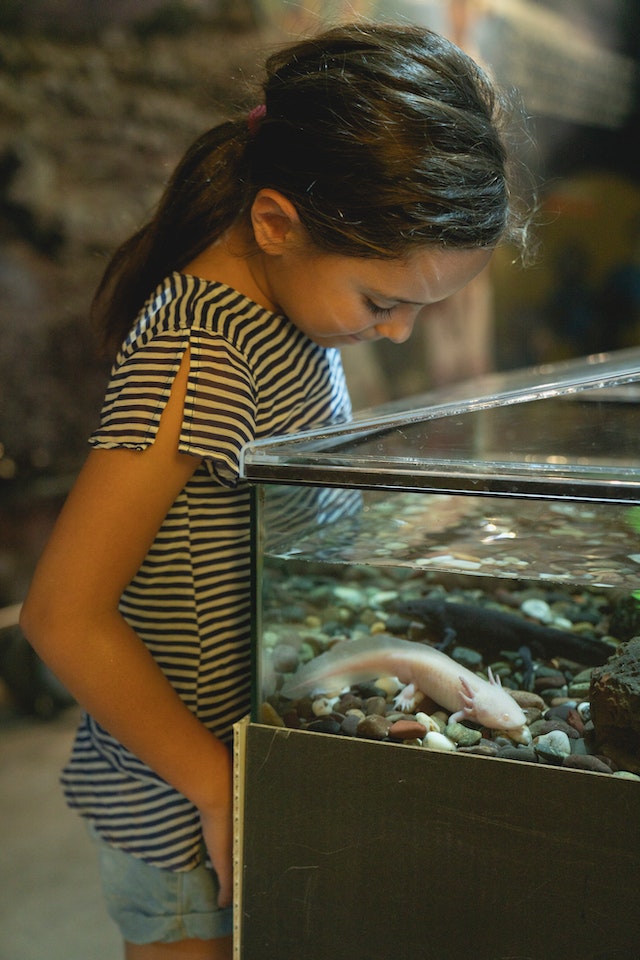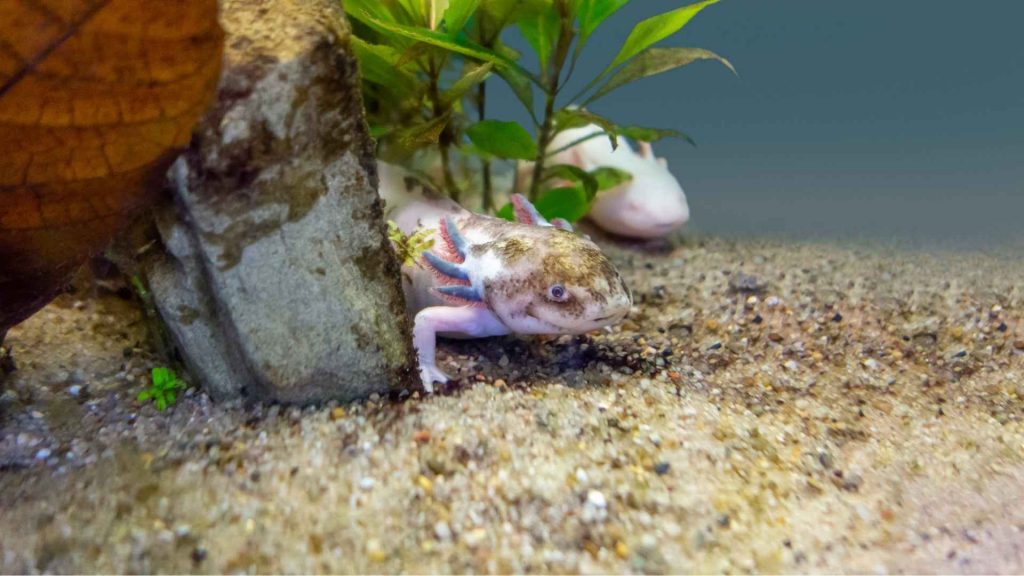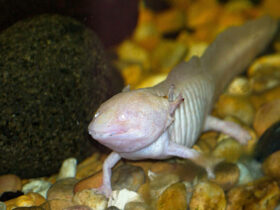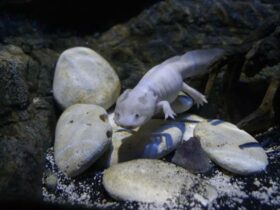
Contents
What Do Axolotls Need In Their Tank? – Introduction

So you’ve decided to bring one of nature’s most adorable amphibians into your home. Congratulations! Axolotls can make fascinating and personable pets. But before you bring your new friend home, you must ensure you have everything set up properly to keep them happy and healthy. Axolotls may look like aliens but have some basic needs like any other pet.
Setting up an axolotl tank is simple, but there are a few essential things you’ll need to provide. Things like a spacious tank, a secure lid, hiding places, a filter and pump to keep the water clean, a chillier water temperature, and food for your axolotl. Get the conditions right, give your axolotl plenty of care and attention, and you’ll have a companion that can live 10-15 years.
So what do these adorable amphibians need to thrive in captivity? Read on for the necessities to keep your axolotl healthy and happy.
New Axolotl Checklist – What Do I Need for My New Axolotl? :https://m.youtube.com/watch?v=sNVPaSlVxDA&pp=ygUlV2hhdCBkbyBheG9sb3RscyBuZWVkIGluIHRoZWlyIHRhbms_IA%3D%3D
A Spacious Aquarium: Axolotls Need Room to Roam
An axolotl needs plenty of space to swim and explore, so get the biggest aquarium possible. A 20-gallon-long aquarium is a good size for a pair of axolotls.
Axolotls produce a lot of waste, so powerful filtration is a must. An under-gravel filter with a charcoal filter pad works well for axolotls. Perform regular water changes of about 25% of the tank volume weekly to keep conditions clean.
Axolotls prefer cold water, so you’ll need a chiller and thermometer to keep the temperature between 60 to 68°F. Axolotls become stressed in warm water, which can weaken their immune system.
Axolotls need hiding spots to feel secure. Provide caves, tunnels and plants for them to hide in and under. Live or silk plants are best, as plastic ones can injure axolotls. Place a layer of fine aquarium sand or gravel on the bottom of the tank for traction. Large gravel can be accidentally ingested.
Axolotls are carnivores, so feed your axolotl a diet of earthworms, waxworms, shrimp and quality pelleted food. Adults can eat every 2-3 days. Never overfeed, as it fouls the water and can cause obesity.
Perform regular water testing to ensure good conditions—test for ammonia, nitrite, nitrate and pH. Ammonia and nitrite should be 0 ppm, nitrate less than 20 ppm and pH between 7.4 to 7.8.
Your axolotls can live 10-15 years with the right setup and care. Meet their needs, keep their home clean and enjoy watching these fascinating salamanders!
A Filter and Pump: Keeping the Water Clean and Oxygenated
To keep your axolotls healthy and happy, you must provide a few essentials in their tank. The two most important things are a filter to clean the water and an air pump to oxygenate it.
A filter removes waste and toxins to keep the water conditions pristine. A low-flow filter with no hard edges they could injure themselves on is best for axolotls. A sponge or box filter works great and won’t create too strong of a current. Be sure to change about 25% of the tank water weekly, along with rinsing the filter media in old tank water.
An air pump and stones help saturate the water with oxygen, which axolotls need to breathe. Axolotls have external gills and absorb oxygen directly from the water. Place a few air stones in the tank and run an air pump to bubble the water vigorously. This also helps prevent stagnation and the growth of anaerobic bacteria.
Other necessities include a proper tank size (at least 20 gallons long), a secure mesh or glass tank cover, aquatic sand or gravel substrate, hides and decor for enrichment, a heater and thermometer to maintain a temperature of 60 to 68 F, a tank light on a timer, and water testing kits to monitor conditions.
Providing pristine, well-oxygenated water and an enriching environment will keep your axolotls thriving for 15-20 years. It may require daily maintenance, but seeing your axolotls explore and interact in a healthy tank will make it worthwhile! Keep your little creatures of the lake happy, and they’ll bring you years of enjoyment in return.
Hiding Spots: Providing Shelter and Security for Your Axolotl
Axolotls are social animals and enjoy having places to hide in their tank. Providing shelter and hiding spots helps reduce stress and gives your axolotl spots to retreat when they want to be alone.
Hiding Spots
Include some hiding spots in your axolotl’s tank-like:
• Terracotta pots: Place a few upside-down terracotta pots of varying sizes in the tank. Axolotls can swim in and out of the openings and rest inside. Bury about 1/3 of the pot in the substrate so it stays in place.
• Coconut caves: You can find coconut caves and shells specifically meant for aquariums that axolotls will love. Bury part of the cave in the substrate to hold it down.
• Aquarium plants: Live or silk plants provide shelter and shade. Plant them throughout the tank, especially in corners. Your axolotl will weave in and out of the leaves and possibly rest within a dense plant.
• Driftwood: Add a few pieces of driftwood to the tank, propped up by rocks to make little caves. The spaces under and between the driftwood make perfect hiding and resting spots.
Providing multiple hiding spots, especially in different areas of the tank, allows your axolotl options to choose from and the ability to get away from tankmates if needed. Hiding spots also give young axolotls, in particular, a sense of security until they become more comfortable exploring the open areas of the tank.
Overall, hiding spots are essential for reducing stress in your axolotls and giving them spots to retreat when they want to be alone. Giving your axolotl shelter and hiding places will help them live a long, happy life.
The Right Substrate: A Soft, Fine-Grained Material for the Tank Bottom
The substrate, or material you put at the bottom of the axolotl tank, is one of the most important parts of their habitat. Axolotls need a soft, fine-grained substrate that won’t hurt their delicate gills or skin. Some good options include:
• Fine aquarium sand – Make sure any sand is specifically meant for aquariums and is fine-grained. Larger sand grains can still cause impaction if eaten. Rinse the sand thoroughly before adding it to the tank.
• Bare-bottom tank – Having no substrate is a simple option and easy to keep clean. Place some smooth rocks, terra cotta pots, or PVC pipes on the bottom of the tank for enrichment.
• Aquarium rocks – Smooth, rounded rocks that are too big for your axolotl to swallow make a good substrate. Make sure any rocks are inert and aquarium-safe. Arrange the rocks to provide hiding spots and climbing areas.
• Tile or slate – Polished natural stone tiles or slates can make an attractive bottom for an axolotl tank. Be careful to sand down sharp edges before placing them in the tank. Leave space between tiles for waste to fall through.
Avoid any substrate with sharp edges like gravel, crushed coral, or aquarium plants with sharp leaves. These can scrape and cut your axolotl and should never be used. Also, avoid dyed or treated substrates, as the chemicals can leach into the water and harm your axolotl.
Regular siphoning and partial water changes are important to keep any substrate clean, as waste buildup can spike water conditions and make your axolotl sick. No matter which substrate you choose, monitor your axolotl closely at first to ensure they do not try to eat it. Ingesting substrate can cause life-threatening impaction and blockages. If eating substrate becomes an issue, you may need to switch to a bare-bottom tank for the safety and health of your axolotl.
What Do Axolotls Eat: A Nutritious and Varied Diet for Your Salamander
Axolotls are carnivorous salamanders, so they need a diet high in protein and nutrients to stay healthy and happy. As axolotl owners, we must provide our aquatic friends with various foods to keep them well-fed.
High-Quality Pelleted Food
Pelleted axolotl food should comprise about 75% of your diet. Look for a pellet for axolotls or aquatic salamanders high in protein, around 40-50%. Popular, highly-rated brands include Rangen Axolotl Pellets and Aquatic Foods Axolotl Sinking Pellets. Only feed as much pelleted food as your axolotl can eat in about 2 minutes, 2-3 times a day.
Earthworms
As treats, offer your axolotl nutritious earthworms, like red wigglers or Canadian nightcrawlers. Axolotls go crazy for earthworms! Chop larger worms into bite-sized pieces for small axolotls. Only feed 2-3 worms per week to avoid obesity and nutrient deficiencies from an imbalanced diet.
Other Protein Sources
You can also supplement your axolotl diet with the following:
• Bloodworms: Live or frozen, high in protein. Only 2-3 times a week.
• Shrimp: Cooked, shelled, unseasoned shrimp. Chopped or whole for large axolotls. Only 2-3 times a week.
• Feeder Fish: Live feeder fish like comets or proxies. Only feed occasionally due to high-fat content and risk of disease. Never leave feeder fish in the tank.
A balanced and varied diet will keep your axolotl at a healthy weight and give them all the nutrients they need to live a long, happy life. Be careful not to overfeed, only provide extra treats in moderation, and always remove any uneaten food from the tank within a few hours to keep the water conditions pristine. Your axolotl’s health and growth depend on you providing the right type and amount of nutritious food.
Conclusion
So there you have the basics to keep your axolotl happy and thriving in their aquatic home. By providing the right filtration, temperature, decor, frequent water changes, and a varied diet, you’ll become a model axolotl owner. Give your little friend the best life possible with the proper care and conditions. Before you know it, you’ll be rewarded with a long-lived, fascinating pet and a lifetime of memories together. Now give your axolotl an extra worm – they deserve it!
More Links :
Do Axolotls Have To Live In Saltwater?
Do Axolotls Live Long? – Uncovering the Mystery of Axolotl Longevity





Leave a Reply